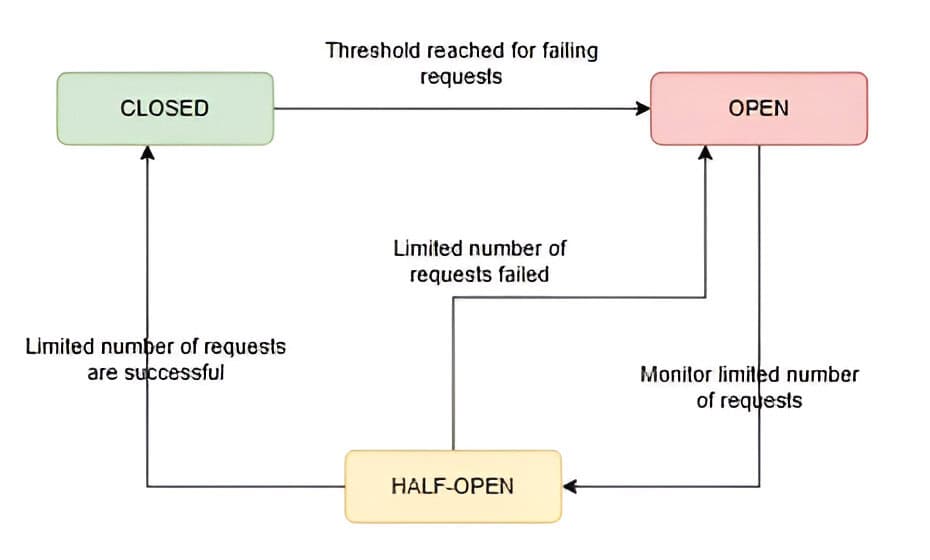1. Introduction
Unlike monolithic architectures, microservices enable developers to break down applications into smaller, independent services. While this architecture offers numerous benefits, it also introduces complexities, particularly in managing failures.
In a microservices ecosystem, if one service becomes unresponsive, it can create a ripple effect, overloading dependent services and potentially causing a complete system failure.
In this tutorial, we’ll discuss one of the most effective strategies for handling such failures in microservices – the circuit breaker pattern.
2. What’s the Circuit Breaker Pattern?
The circuit breaker pattern is a design pattern used to detect and manage failures gracefully in a distributed system. It monitors communication between microservices and temporarily halts requests to a failing service, giving it time to recover. This helps avoid further strain on the failing service and prevents a domino effect.
It helps us determine whether the downstream service functions correctly by monitoring service interactions. If not, the circuit breaker trips and subsequent requests are either rejected or redirected, ensuring system stability.
3. How Does the Circuit Breaker Work?
The circuit breaker operates in three states: closed, open, and half-open. Each state has a clearly defined purpose and transition rules.
3.1. States
In the closed state, everything operates as expected. Requests flow seamlessly to the service. If a failure occurs, the circuit breaker monitors performance metrics, such as error rate, response time, and timeouts. Once the error rate surpasses a defined threshold, the circuit breaker transitions to the open state.
When the circuit breaker is open, it stops forwarding requests to the failing service. Instead, it can either return a predefined fallback response or an error message. Thus, this state allows the failing service to recover without additional pressure.
Finally, after a cooling-off period, the circuit breaker transitions to the intermediate state we call half-open. The cooling-off period allows the failing service time to recover and stabilize. In the half-open state, the breaker allows a few requests to pass through and tests if the service has recovered. If these requests succeed, the circuit breaker moves back to the closed state. Otherwise, it reverts to the open state.
3.2. Transitions
Let’s see how the breaker transitions from one state to the other:

The circuit breaker starts in the closed state, allowing requests to pass through to the service. Meanwhile, as requests are processed, the circuit breaker monitors for failures. If the number of failed requests exceeds a predefined threshold within a specific time window, the circuit breaker transitions to the open state.
After a timeout period, the circuit breaker moves to the half-open state. In this state, a limited number of requests are allowed to pass through. If these requests succeed, the circuit breaker returns to the closed state. However, if these requests fail, the circuit breaker remains in the open state for another timeout period. This prevents the system from sending further requests to the failing service.
Finally, if the limited number of requests in the half-open state are successful, the circuit breaker transitions back to the closed state.
By monitoring and transitioning between these states, we can ensure minimal disruption during service failures.
4. Implementation in Modern Microservices
The circuit breaker pattern is widely implemented using frameworks and libraries integrated with microservices platforms.
For instance, Netflix’s Hystrix was a popular library for this purpose, though it has since been deprecated. However, alternatives like Resilience4j and Spring Cloud Circuit Breaker are now commonly used. These libraries allow developers to configure the pattern with minimal effort, including parameters like failure thresholds, timeout durations, and recovery mechanisms.
5. Advantages and Challenges
The circuit breaker pattern is primarily used to improve a system’s resilience and fault tolerance. It helps avoid resource exhaustion by preventing repeated attempts to connect to a failing service. Thus, it fails fast rather than allowing prolonged delays.
This pattern also aids in system monitoring by offering valuable insights into the performance and reliability of services.
However, implementing a circuit breaker comes with challenges. Fine-tuning thresholds and timeouts requires a deep understanding of service behavior, as misconfigurations can cause unnecessary trips and degrade performance. The pattern also assumes services will recover over time, which may not always be the case.
Additionally, circuit breakers may add complexity to system design, requiring mechanisms to handle false positives and fallback strategies, such as caching or default responses, to enhance resilience.
6. Conclusion
In this article, we explored the circuit breaker pattern and its importance in maintaining resilience within microservices architectures. We explored how the pattern works, including its core states and the role each plays in handling failures gracefully. Finally, we discussed the benefits it offers as well as the challenges involved in its implementation.
By acting as a safeguard against cascading failures, a circuit breaker enhances the reliability and robustness of distributed systems. This pattern is especially valuable in scenarios involving temporary failures or high latency. By isolating the problematic services, it ensures the system remains stable and continues to perform effectively.